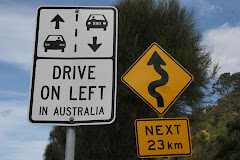Driving a car in Australia does have its ups and downs. I've written previously (Left is Right and Right is Wrong) about the strange sensation of sitting on the right side of the car to drive on the left side of the road (opposite to how things are done in the USA). Once you get the hang of doing everything opposite to the way you are accustomed, the road rules, traffic signs, etc are quite similar to what you would find in the USA. Similar enough in fact that I didn't actually have to take a proper road driving test here in Australia to get my license. I did have to pass a 30 question written examination to test my knowledge of the road rules, but I didn't have to go in the car with an examiner and prove my actual driving skills. That's a lucky thing because I probably would have failed immediately when I walked to the left side of the car to get in and tried to steer the glove box!
For the most part though, my driving in Australia has gone relatively smoothly. I've adapted to life on the left side of the road and the nuances of driving in Melbourne, which include hook turns in the city and sharing the road with trams, have become second nature. In general, I'd say traffic in Melbourne is more fluid than traffic in the USA. The lanes are painted on the road, but people move in and out of them with great regularity and will sometimes indicate and other times not. I remember spending the first few months of the time the Handsome Australian and I lived in the USA together telling him to "Choose a lane and stay in it!!" I didn't understand why he was constantly in the center of the road. Now that I've driven in Melbourne, I get it. That's just how people drive here.
If you think that sounds like a recipe for chaos, then wait until the traffic signals go out in Melbourne. That's when all hell breaks loose. In my 8 years Down Under, I've only experienced outages in the traffic signals twice. Once was a few years ago on my wait to visit the dentist and one was last week. On both occasions the lights that were out were servicing major intersections and the absence of the traffic signals left dozens and dozens of drivers in a dangerous and ridiculous mess.
Why? Why were these situations so chaotic? I'd been in many similar situations in the USA when traffic lights had failed for one reason or another and yes it was sometimes confusing, but for the most part, people were able to manage the situation by reverting to the rules of a four way stop.
And that my friends is exactly why the Australians simply can't cope when the lights go out...there is a shortage of four way stops here. In fact, I can't even think of an intersection I've been through here where such a thing existed. Most intersections where we'd have four way stops in the USA have roundabouts or traffic circles here in Australia. They work similar to a four way stop except the traffic is more fluid because you are traveling around in a circle. This means that more than one car might enter the circle at the same time, but not be in danger of hitting one another because they are essentially following each other around. In a four way stop situation, each side must take turns to cross the intersection otherwise they'd collide in the middle.
It's my opinion that traffic circles or roundabouts keep traffic flowing better than a four way stop system. That is until the traffic lights at an intersection go out and no one has a secondary system to fall back on. Then it's every man for himself. Then it's chaos. Then in that moment, you miss the good old USA and the regimented four way stop system.
Isn't it amazing the things that you miss from home?
Rolex’s Enduring Love Affair with Tennis
3 days ago









1 comment:
Although there may not be abundance (or any) four way stops... I would think that people would revert to the "take turns" method. All kids who have a sibling or been a part of the school system should understand the concept.
I do like the rondas (roundabouts) they have those in Spain as well and I found them easy to navigate...well maybe it would be more complex in an outage situation ;)
Post a Comment